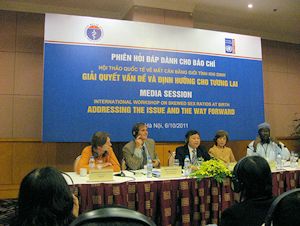Promoting Gender Equality and Women’s Empowerment is Key to Correcting Imbalance Sex Ratio at Birth
Date:

Local and international experts on correcting Imbalanced Sex Ratios at Birth, October 2011.
Credit: Krista Seddon, UN Women
Sushma Kapoor, Deputy Regional Director, UN Women South Asia, spoke as a representative for UN Women on a joint United Nations panel to address the United Nations commitment to addressing sex ratio imbalance.
According to international and national experts, the level of SRB increases in accordance with birth order. For example, in Viet Nam in 2009 the SRB was 110.2 for the first birth and slightly lower, at 109, for the second birth. However, for the third or later births the SRB was above 115. This observation suggests that prenatal sex selection could have been adopted by a number of couples even during their first pregnancies. One of the main factors behind this SRB rise relates to son preference, which is deeply rooted in many Asian countries for cultural, social and economic reasons.
A skewed SRB will affect the population sex ratio structure in the future, which, in turn, will result in a situation where there is an excess of males in society. Scarcity of women could increase the pressure on women to marry at a younger age, often sacrificing educational opportunities, there may be a rise in demand for sex work, and trafficking networks may also expand in response to this imbalance.
Resident coordinator of United Nations Viet Nam, said “To keep up momentum toward achieving Millennium Development Goal number 3 on gender equality in Viet Nam, efforts need to be dedicated to changing couples’ traditional preference for male children, as well as towards empowering women’s position in the family and society as a whole. More qualitative research is also needed so we can better understand the underlying social and cultural factors behind the SRB imbalance. This will in turn, provide a foundation n for improving education activities and other interventions.